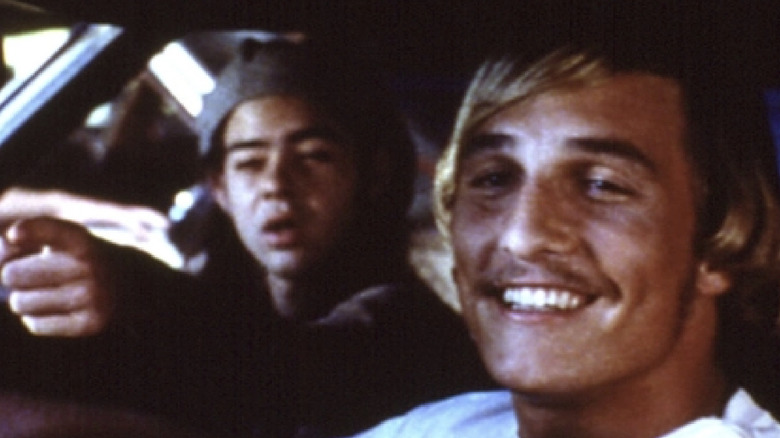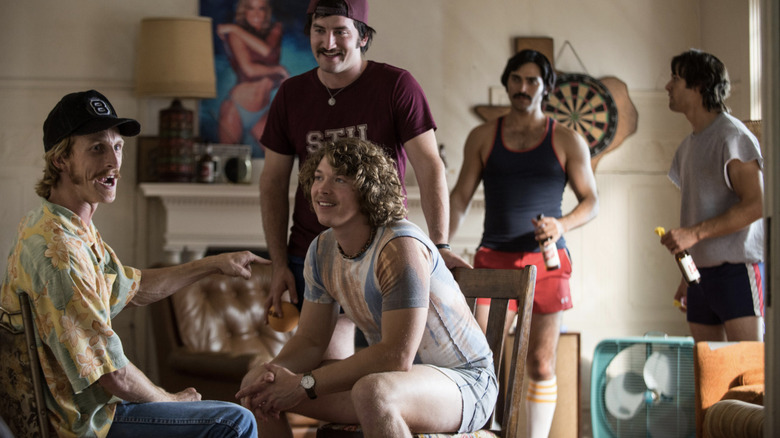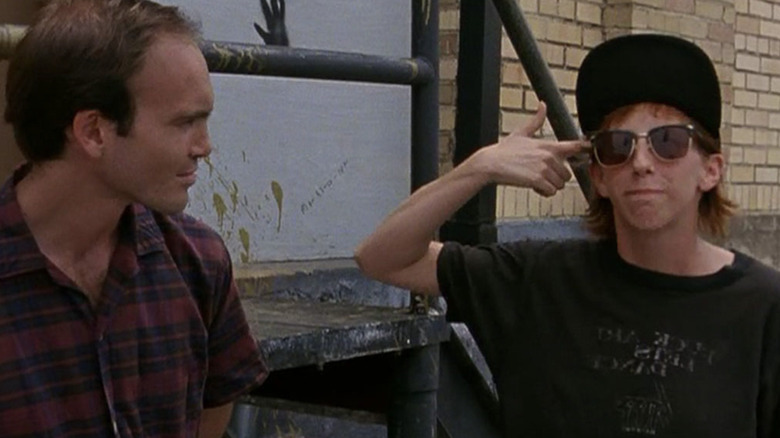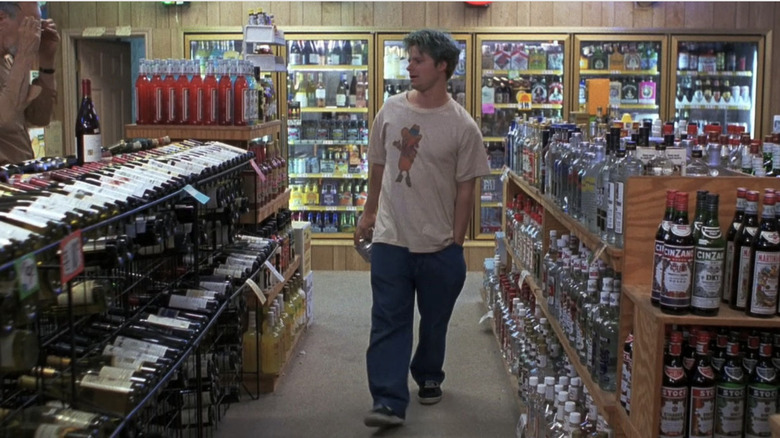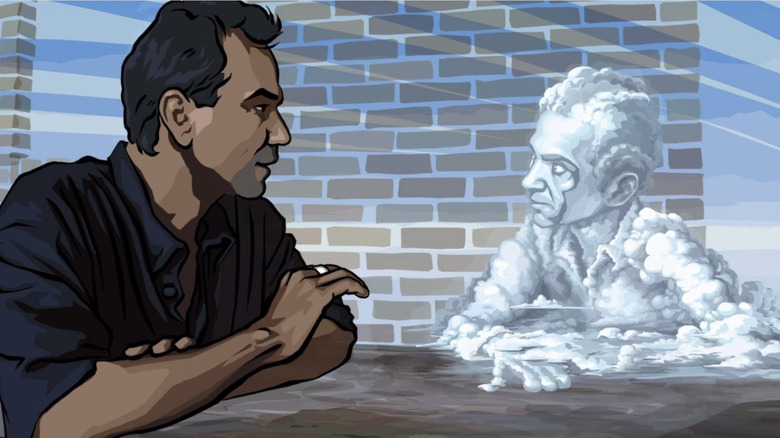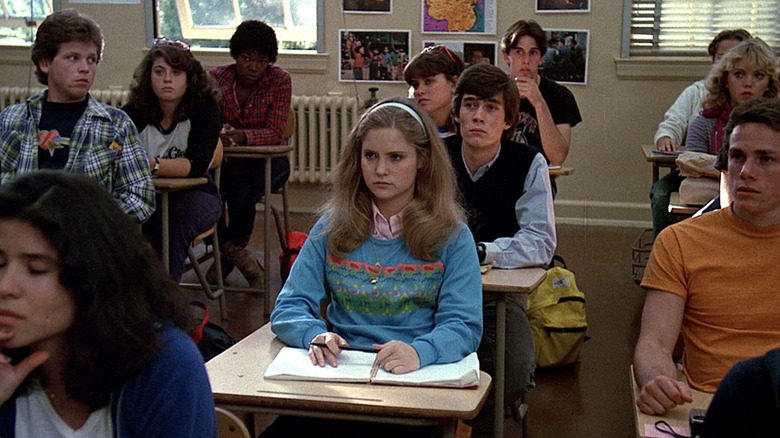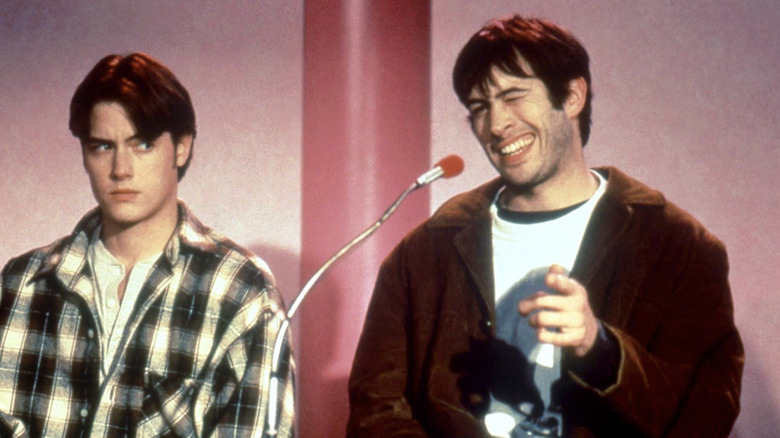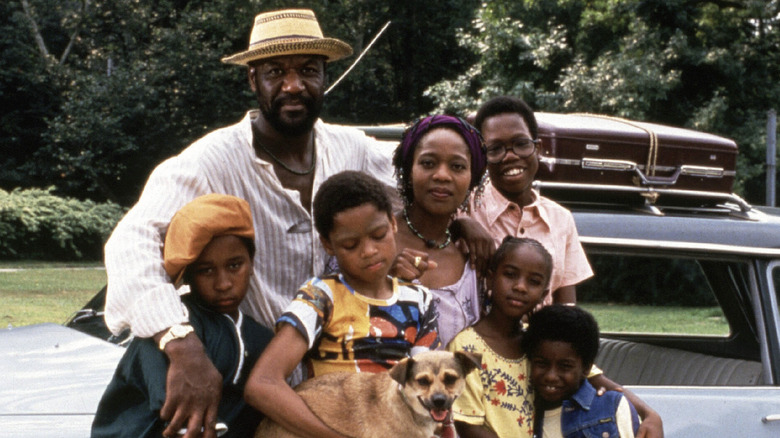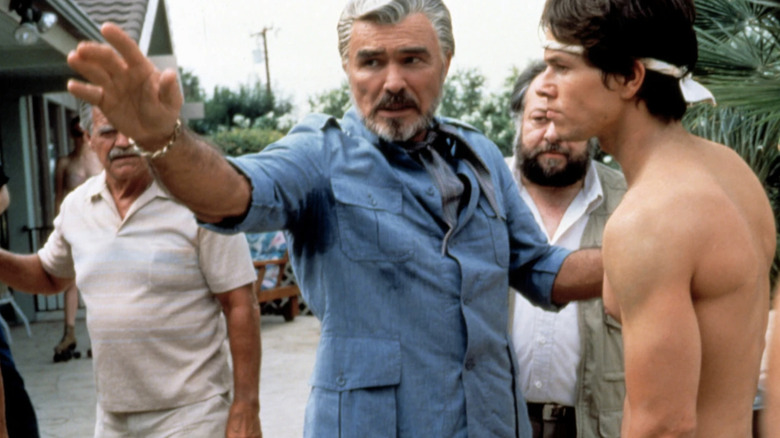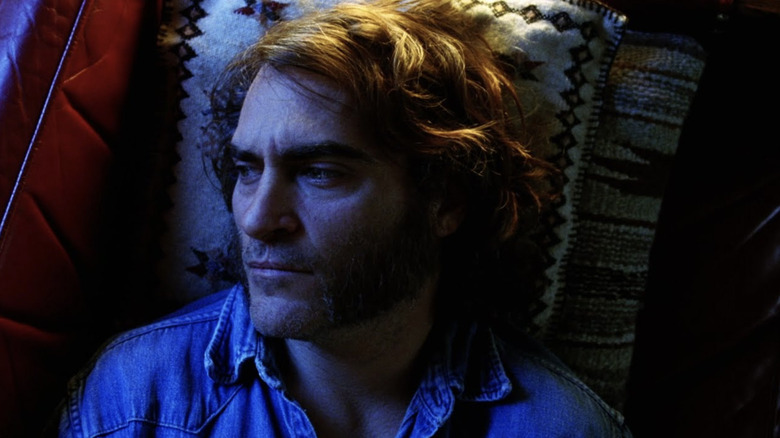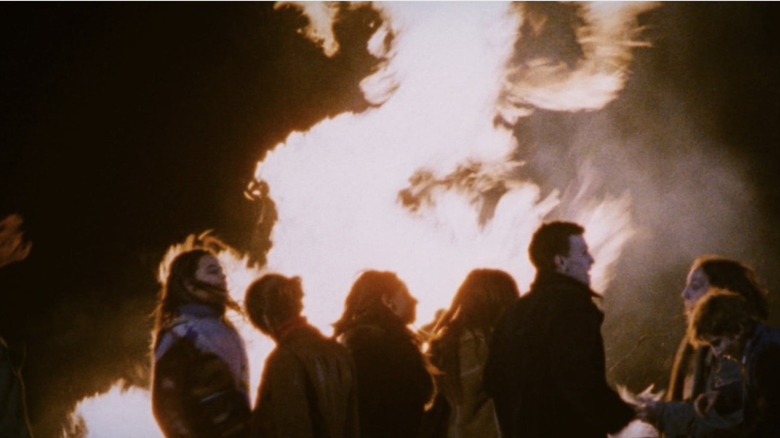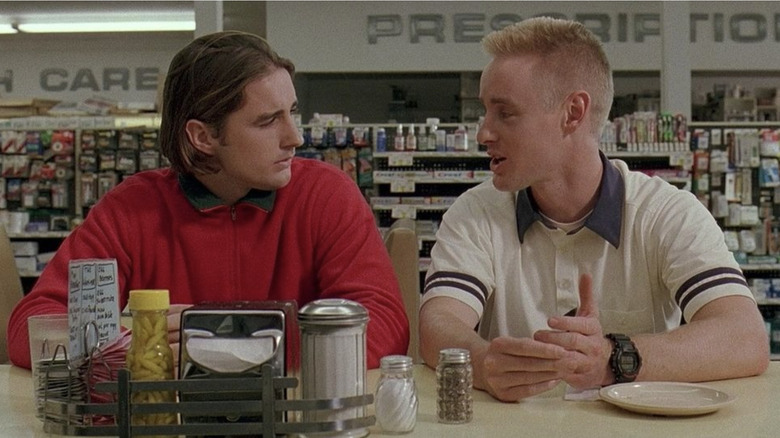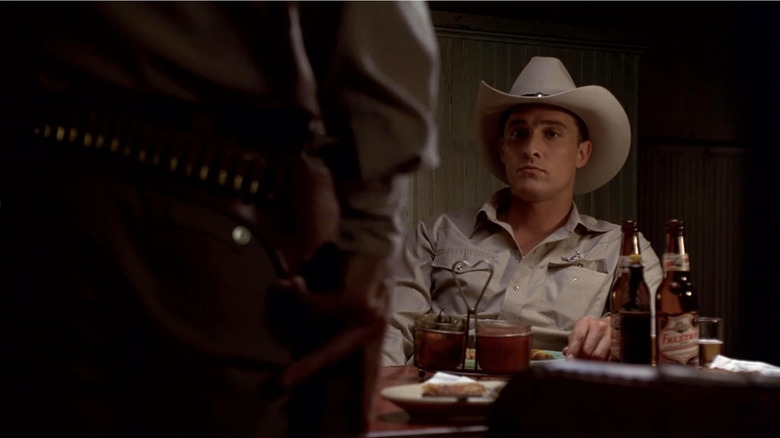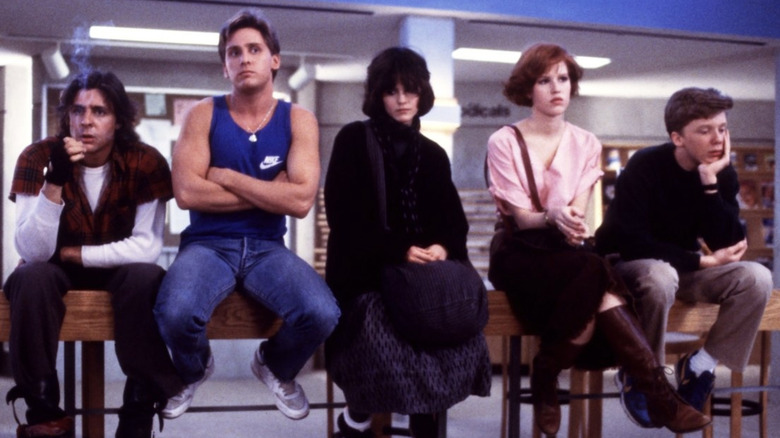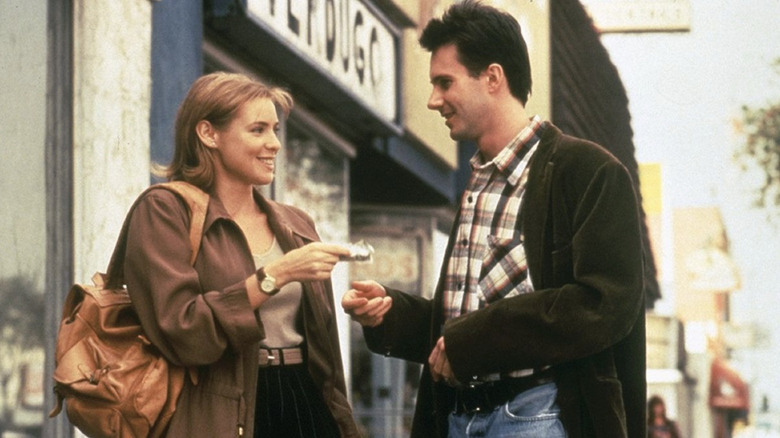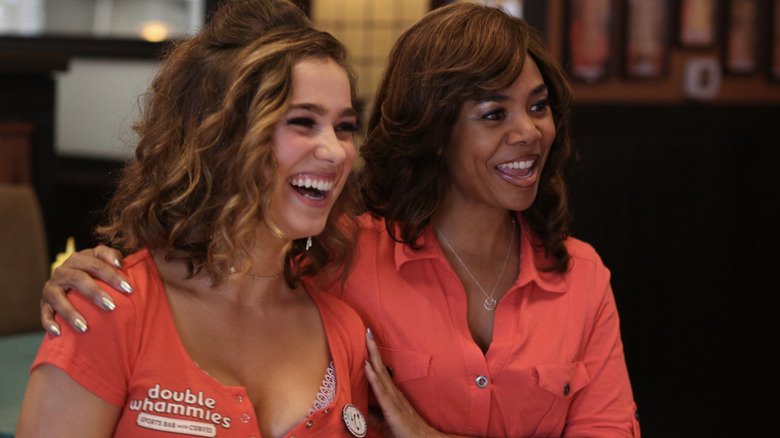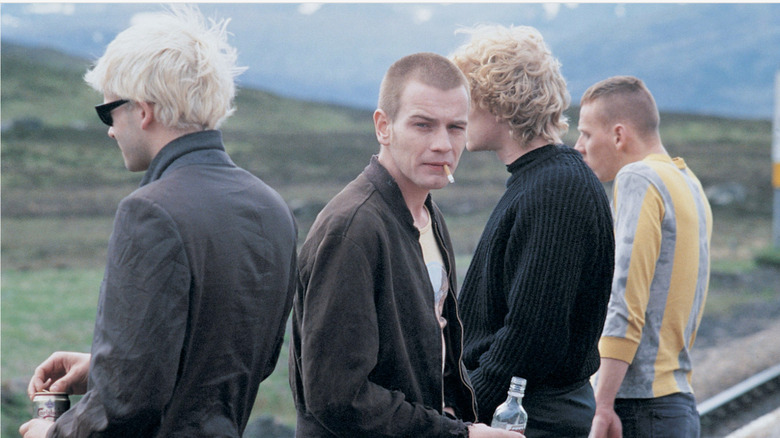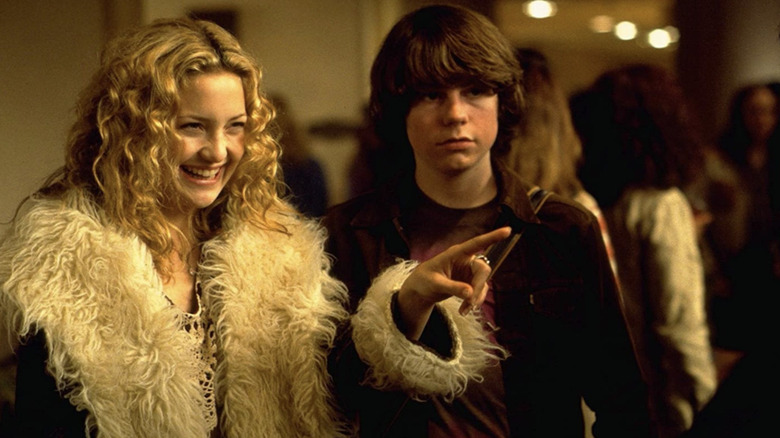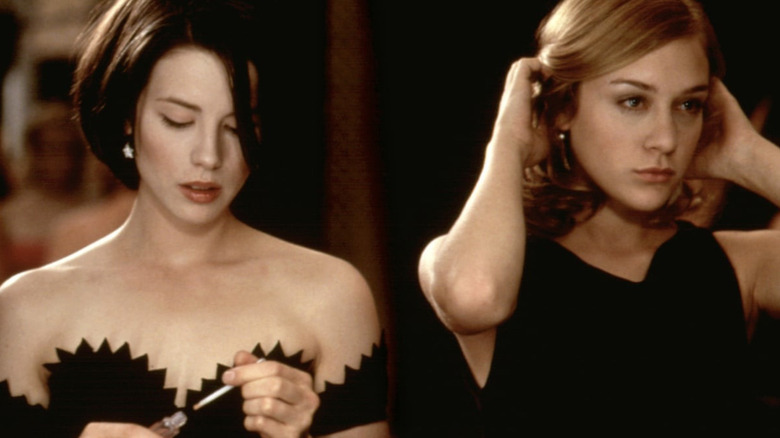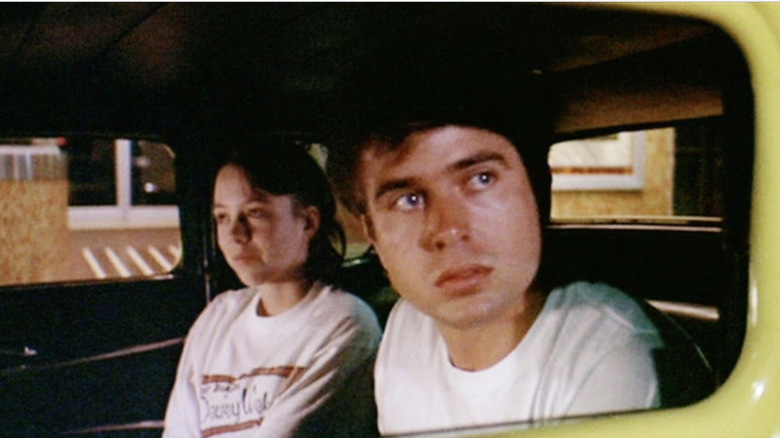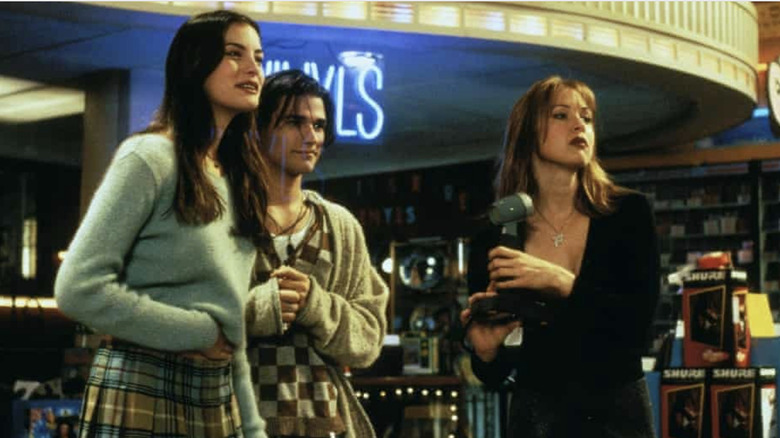20 Movies Like Dazed And Confused You Should Watch Next
We may receive a commission on purchases made from links.
Richard Linklater's teen classic "Dazed and Confused" partied at the Moon Tower in 1993; or more accurately, it had barely tapped the keg when the party got shut down. Opening in about 200 theaters, the film came and went quickly, taking in about $8 million. But like "Friday," "Man Bites Dog" and "Office Space," it became a home video word-of-mouth success story that was seemingly always rented out at your local Blockbuster Video.
The cast were mostly unknowns, peppered with indie darlings and up-and-comers like Parker Posey, Joey Lauren Adams and Milla Jovovich. But it would become one of those films like "American Graffiti" or "Diner," something you watch decades later and marvel at the fact that someone knew to cast Ben Affleck, Matthew McConaughey, Adam Goldberg, Cole Hauser and those aforementioned actresses, among others.
Depicting Texas teens on the last day of high school in 1976, what makes "Dazed" so special is the specificity and charm of Linklater's script, where even the smallest ritual of teenage existence is made savored and recalled with bittersweet affection. While the specifics may come from Linklater's '70s adolescence, the film makes them feel universal, and his dialogue deals with issues of uncertainty to which teens from any time can relate.
Not many filmmakers have Linklater's gift for on-target conversation detailing the small moments of human nature, but a few special ones do. With that in mind, here are 20 films ideal for keeping the "Dazed" party going, whether in detail, in setting, or in a spot-on portrayal of youth.
Everybody Wants Some!! (2016)
Sometimes filmmakers refuse to make sequels, but will make wink-wink movies that are very much aimed to delight the same audience and vaguely traffic in the same story beats — think "Casino" to "Goodfellas" or "Carlito's Way" to "Scarface." While Linklater was developing "Everybody Wants Some!!," he often referred to it as a "spiritual sequel" to "Dazed," and thankfully, it very much is that.
While "Wants" doesn't follow any of the same characters, and is set in 1980, it continues many of the best elements of "Dazed." The music is great, the film's vibe is very much a main character, and rather than building a narrative, it just want to linger. It's such a pleasure to spend time in this movie's world, in fact, that you'll be bummed when it eventually has to end.
Now detailing college rather than high school, the music has gone from Aerosmith and Foghat to Van Halen and The Cars, but otherwise not much has changed; the characters are still baseball players taking the same drugs and going to the same parties. Linklater once again assembles a great young cast to play those baseball players, particularly a scene-stealing Glen Powell. But "Everybody" eventually does differentiate itself from "Dazed" by centralizing a romance between the main character (played by Blake Jenner) and an arts major (played by Zoey Deutch). The third act mostly leaves the other characters behind to show them falling in love, and their chemistry gives this an unexpected spark closer to Linklater's "Before" trilogy than "Dazed."
Slacker
Linklater first film was a key foundation in the '90s indie film boom, serving as inspiration for the careers of people like Kevin Smith.
"'Slacker' was the film that got me off my a**," Smith would later say of the film he saw on the night of his 2st birthday.
Focusing on an ensemble of captivating, verbose characters (Linklater included) without forcing a plot on them, "Slacker" is a collection of vignettes about people in and around Austin, many with some kind of eccentric interest or hobby. They talk to whoever will listen, sharing theories about the Kennedy assassination and recounting scenes from "The Wizard of Oz" and old "Scooby-Doo" episodes. The effect is less like watching a movie and more like eavesdropping on everyday conversations; there's not much happening, but it doesn't matter when the speakers have such intriguing things on their minds.
Together, this "Slacker" pastiche creates a picture of life on the fringes of mainstream society. It also announced with authority a unique American voice that would make some of the best films ("Boyhood," "Dazed," the "Before" trilogy) of the next several decades.
SubUrbia (1996)
Adapted from Eric Bogosian's play, this flick about aimless teens marked the first screenplay Linklater directed but didn't write; as a result, the differences between this and the rest of Linklater's films are as obvious as the similarities.
"SubUrbia" is about young men and women who spend most of their time loitering near the local convenience store. When one of their former friends, now a successful rock singer, returns to town, they take out resentments about their own lack of success and ambition on him. There's some comedy in "SubUrbia," particularly from Steve Zahn as the goofiest member of the friend group, but it's more bitter than funny, no one liking each other's company even before they start fighting each other. There's none of the "Dazed" youthful optimism about the future, these characters have no future and no desire to even have a future. "SubUrbia" can be a tough watch at times, but by the end it is a powerful study of people with no purpose and a lot of hidden rage.
Waking Life (2001)
Another brilliantly provocative, outside-the-box, dialogue-driven Linklater film that you don't watch so much as immerse yourself in, "Waking Life" is one of a handful of projects the writer/director used rotoscope animation to bring to life.
While many other "Dazed" cast members later became successful actors, Wiley Wiggins (who played Mitch), largely sidestepped Hollywood. One of his few notable projects was this one, where he plays the guide for several discussions about the meaning of dreams and sleep.
"Waking Life" is structured much like "Slacker," with the Wiggins character wandering from one character to another as they have long conversations about dreams and the unconscious mind. What makes "Waking Life" unique is the style Linklater applies to these conversations, first shooting the scenes in live-action and then painting over them with digital animation. The effect is hypnotic, where backgrounds are always in motion and people can suddenly become cloud formations.
It's an inspired method for visualizing the feeling of a dream, and while the images sometimes threaten to distract, they often help keep focus on the words being spoken, providing colorful interpretations of the speaker's thoughts. Linklater doesn't often go this stylized (although he would again a few years later with "A Scanner Darkly"), but here he found a perfect match of style and material, showing the viewer new worlds as they're being described.
Fast Times at Ridgemont High (1982)
"Dazed" owes its cast of future stars to casting director Don Phillips. It wasn't Phillips' first time discovering young actors who would become the biggest talents of their generation, however; he was also the casting director on 1982's "Fast Times at Ridgemont High," overflowing with names ranging from Sean Penn to Jennifer Jason Leigh, Phoebe Cates, Judge Reinhold, Eric Stoltz, Forest Whitaker and Nicolas Cage.
Similar to "Dazed," the pleasure of looking back now on "Fast Times" comes not only from the future big names, but from the nuanced characters and writing those names had at their disposal.
"Fast Times" has been largely defined in pop culture by Jeff Spicoli, Penn's laid back stoner character who could easily fit into "Dazed." But he's more an occasional source of comic relief than the focus of the movie. The actual focus is Leigh as a high school student dealing with the everyday pressures of being a teenager. Some of her problems are comedic and some are more serious, but director Amy Heckerling and writer Cameron Crowe present them all with a light touch and no judgment. While the attitudes of some '80s teen comedies towards women and sex have aged poorly, "Fast Times" remains relevant and sensitive without giving up the pleasures of a good joke.
Mallrats (1995)
Thanks in part to Linklater's inspiration, Kevin Smith was coming off the indie success of "Clerks" when he moved to a major studio to make his follow-up, the 1995 comedy "Mallrats." Both "Mallrats" and "Dazed" were produced by the same company, share some of the same cast members including Affleck and Adams, and were considered commercial bombs upon their release. But like "Dazed," it found a cult audience on home video, one so considerable in fact that Smith has been working on a sequel for years.
"Mallrats" is an imperfect movie, with Smith not seeming as comfortable with larger-scale production as Linklater was. Thirty minutes had to be cut out of the film after poor test screenings, and the resulting narrative is sloppy with important information left off-screen.
Jeremy London, brother of "Dazed" star Jason London, is not a very compelling lead, stiff in his deliveries of Smith's profane, frequently high-degree-of-difficulty dialogue. But despite its problems, "Mallrats" is a delight, thanks to Smith's amusing observations on comic books, Magic Eye drawings and mall culture — as well as Jason Lee's star-making performance as the second lead.
Don Phillips cast "Mallrats" in addition to "Dazed" and "Fast Times," and Lee is one of his greatest finds, captivating even as he acts like he's above it all. Lee would later apply his talent at charming snark to many films and his own hit TV series "My Name Is Earl," but he has never been funnier.
Crooklyn (1994)
Many of the best directors of the '80s and '90s were children of the 70s, and a lot of them made movies about growing up at in that time period. Spike Lee was one such director, and his 1994 drama "Crooklyn," based on his memories of growing up in '70s Brooklyn, is up there with "Dazed" as one of the best movies about being young at that time.
The making of "Crooklyn" was a family affair, with Lee co-writing the script alongside his siblings Cinque and Joie. It primarily focuses on a character based on Joie Lee — a young girl named Troy Carmichael living with her large family in a small apartment. Lee's skills as a visual filmmaker make him ideal to direct a movie about childhood, where he can film kid fantasies like a scene where the characters are upside-down in otherwise normal settings.
Lee also masterfully conveys the sense of community in the Carmichaels' neighborhood, showing the support and fun that made life enjoyable even as times were tough. An extended sequence where Troy moves to her aunt's house in the South is jarring because that community is gone, and the nicer house does nothing to help the loneliness of not having your friends around.
Boogie Nights (1997)
Like Linklater, writer/director Paul Thomas Anderson followed a respectable independent debut with a '70s period piece overloaded with characters and songs. But while Linklater made "Dazed" relatively small despite the major studio behind it, Anderson made "Boogie Nights" as expansive as possible, portraying the decline of the pornography industry with a bold visual flourish in every shot.
Like "Dazed," the success of "Boogie Nights" is owed partly to its best selling soundtracks, collecting the biggest hits of the '70s and early '80s. One of the signature scenes of "Boogie Nights" foregrounds the soundtrack, with Alfred Molina's paranoid drug dealer playing his mixtape of '80s classics for an audience of potential sellers.
This high-energy music helps sustain the fast pace of much of "Boogie Nights." It breezes through its two-and-a-half hour runtime on the back of good songs, funny conversations, and elaborate camera movements. It also helps that Anderson assembled a cast with as many stars-to-be as "Dazed," giving Mark Wahlberg his breakthrough role and helping bring great actors like John C. Reilly and Philip Seymour Hoffman to mainstream attention. But the good feelings don't last forever, and the movie's eventual turn to bleakness looks ahead to the darker movies Anderson would later make.
Inherent Vice (2014)
PT Anderson's second film about the '70s is a crime comedy with almost as many mind-altering substances as "Dazed." The copious drug use of its main character in particular, private eye Doc Sportello (Joaquin Phoenix), further complicates the already dense plot of "Vice," where even the detective is too high to keep track of all the names and clues. And there are a lot of names, with Anderson assembling a cast full of as many stars as "Boogie Nights" or "Dazed" to play characters who often only have one or two scenes. There's always a new wacky character to meet, and all of them bring bad news.
While "Inherent Vice" is mostly very funny, its vision of the '70s comes to be as bleak as the darkest moments of "Boogie Nights." It's set in 1970, when the hippie dream of love and peace is dying out and there's the constant threat of imminent violence in the air. The mystery Doc is swept up in involves a conspiracy of massive corporations and cruel exploitation of drug addicts, one that's too big and too violent for him to have any chance of defeating. But despite its darkness, "Vice" is not a hopeless film. It believes that even with enemies too big to comprehend, there's still the opportunity to make connections with others and help them out, as a way of tipping the scale towards good and away from evil.
Cold Water (1994)
The year after Linklater made "Dazed," French director Olivier Assayas made "Cold Water," another flick about growing up in the '70s. Both "Water" and "Dazed" follow the journey of their teen characters to a raucous party, but Assayas' vision of teens having fun ends up being darker than Linklater's.
"Cold Water" was unavailable in any form in the U.S. for decades after its release, due to rights difficulties with its soundtrack of classic '70s songs. Thankfully the issue was resolved and "Water" can now be seen with its soundtrack intact. Its climax is a half-hour party scored entirely by the biggest and best '70s songs, played very loud by kids messing with the party's record player. It's exhilarating to watch teenage misbehavior scored by Creedence Clearwater Revival and Bob Dylan, but Assayas also presents a darker side to the celebration, where the partying becomes an outlet for the teens' most volatile emotions. The partiers set a bonfire in the backyard and the uncontrolled flames are a good metaphor for the hormones and anger raging inside of them.
Bottle Rocket (1996)
In the early days of Wes Anderson's signature quirky style, he teamed with the Wilson brothers to make "Bottle Rocket," a small comedy about Texas dreamers. While "Bottle Rocket" lacks the elaborate visuals of subsequent Anderson movies, it more than makes up for it with the charm of its characters and performances that would launch Luke and Owen Wilson's careers while simultaneously resuscitating that of the legendary James Caan.
"Bottle Rocket" has the plot of a crime movie, involving a small-scale bookstore robbery and a local crime boss (Caan), but its tone is gentle comedy rather than exciting action. Its trio of low-level criminals are more lovable losers than outlaws, fulfilling their dreams of better lives for themselves through petty crime.
The most lovable of the bunch is the group's ringleader, Owen Wilson's Dignan, who's so convinced there's a good life ahead of them that he writes up a "75 year plan" for himself. "Bottle Rocket" was Wilson's first feature film performance and even now that he's been working for decades, it remains one of his very best, showcasing his sweetness in addition to his comedic timing. Dignan is an innocent despite his crimes, and the movie runs on the hope that he'll one day figure himself out.
Lone Star (1996)
After "Dazed," it took Matthew McConaughey until 1996 to start getting mainstream attention. That year, he starred in "A Time To Kill" and also had a key supporting role in John Sayles' Texas-set "Lone Star." While McConaughey isn't in much of "Lone Star," he looms large over it as a representation of the complicated, ominous history of the state.
Sayles and Linklater would later collaborate on the crime comedy "The Newton Boys" and they share a similar sensibility, prioritizing character interactions and interesting dialogue over plot. They're also both masters of the ensemble movie, tracking dozens of characters and making them all interesting enough to be the main character of a different movie.
In "Lone Star," all the characters are united by a murder mystery, involving an evil sheriff (Kris Kristofferson) and his seemingly moral successor (McConaughey). What starts as a traditional whodunit becomes something more, where the crime reveals the inequalities and compromises of Texas life going back centuries. Each character is haunted by the past of their state and their families, and as much as they want to move forward, it may not be possible to escape the past. The mystery is solved by the end of the movie, but Sayles leaves it open-ended whether or not that solution will truly solve any of the characters' problems.
The Breakfast Club (1985)
There have always been movies about teenagers, but John Hughes helped elevate the genre to new heights by taking issues of his teenage characters seriously, adding comedy while emphasizing how important such moments feel to a young person. The best example of this is "The Breakfast Club," which tones down the wackiness of "Ferris Bueller" and "Sixteen Candles" in favor of frank conversations about the angst of being a teenager.
"Breakfast Club" played a large part in popularizing the teen-movie cliches that "Dazed" tried to avoid, with its outcasts and popular kids discovering surprising depths and similarities. The large number of movies that have ripped off or been inspired by "Breakfast Club" means that it's hard to watch it with fresh eyes, but it still works in spite of it now being familiar. Even as they've been quoted for decades, Hughes' jokes still get laughs, and he picked an uncommonly talented group of teen actors to sell both the jokes and the emotions. While none of the "Breakfast Club" actors found as much adult success as the cast of "Dazed," they are perfect for this movie, convincingly playing the stereotypes — and the real people underneath.
Kicking and Screaming (1995)
Noah Baumbach's 1996 debut "Kicking and Screaming" tells the story of a group of young friends not unlike the "Dazed" characters, cracking jokes and sharing theories while not knowing what adulthood has in store for them. The difference is that the "Dazed" kids are mostly teenagers, while these characters are adults, delaying the moment they have to grow up as long as they can. This makes "Kicking" a sadder movie than "Dazed," set at an age when the promise of youth has run out but the worst of adulthood is yet to come.
The witty dialogue and well-observed, sometimes unlikable characters of Baumbach's future films are already present in "Kicking." Even when these characters are frustrating in their refusal to move forward, Baumbach portrays those frustrating qualities with one-liners. But it becomes clear as "Kicking" goes on that those one-liners are defense mechanisms against these characters' feelings of anxiety and insecurity. The dialogue is funny because it's being spoken by characters who want other people to think they're funny. By the end, the comedy fades away, leaving people who are unsure how to live life outside a college campus.
Support the Girls (2018)
Writer/director Andrew Bujalski has made his last two movies in Linklater's hometown of Austin, and he shares Linklater's eye for both the boring and the eccentric parts of Texas. This is especially clear in Bujalski's 2018 film "Support the Girls," which shows both the big personalities and the ugly, anonymous strip malls that define Austin.
"Support the Girls" follows an eventful day in the life of the manager of a Hooters-esque chain restaurant, played by Regina Hall. Her struggles with a tight schedule and uncooperative boss are made more tolerable by her friendships with her employees, particularly an energetic waitress played by Haley Lu Richardson. There's no real plot per se, but it's wonderful to spend time with Hall, who tries to stay optimistic even in situations that would seem too depressing to bear. Bujalski follows her example and keeps the tone light, even as it unflinchingly captures the monotony and frustrations of working in the service industry. Like the best Linklater movies, it captures the most mundane aspects of regular life and finds the humor and pathos within them.
Trainspotting (1996)
Linklater was a key figure of the independent film boom of the '90s, when smaller, non-studio films started getting major mainstream and awards attention. One of the biggest movies of the independent wave was Danny Boyle's "Trainspotting," which takes a potentially depressing story about heroin addicts and makes it exciting and funny while not sugarcoating the realities of addiction and poverty. Its depiction of the most rundown parts of Edinburgh is as vivid as Linklater's Texas, lovingly studying subcultures even as members of those subcultures are destroying themselves.
"Trainspotting" introduced American audiences to some of the biggest English and Scottish stars of the time, including Robert Carlyle, Jonny Lee Miller, and Kelly Macdonald. The biggest star of them all, however, would be Ewan McGregor — so effective as main character Mark Renton that his magnetism is already on display. Even when Renton is committing crimes to support his drug habit, he does so with enough charm to make the viewer hope that he succeeds. But his charm does him no good in his lowest moments, and even getting off drugs doesn't guarantee that he'll make a better life for himself.
Almost Famous (2000)
Cameron Crowe's "Almost Famous" applies the loose structure and endearing characters of "Dazed" to the story of the people behind that music. "Famous" is as episodic as "Dazed" and even more sprawling, following its characters across the country rather than just within the confines of Texas.
Crowe was already a great writer of teenagers in "Fast Times" and "Say Anything," and in "Almost Famous" he applies that strength to his own teenage life. Crowe doesn't sugarcoat the social ineptitude of his stand-in character, young rock journalist William Miller, juxtaposing his awkward attempts at conversation with the confident rock stars he's gone on tour alongside. He's endearing in the way a real teenager is endearing, inarticulate but trying above all to be kind. His earnestness is far from the callousness of his rock star subjects, who throw away women when they feel like it and don't seem to care about anyone beyond themselves. While "Famous" has a lot of nostalgia for its time period and music, it allows moments of pettiness and egomania to puncture its blissful vibes and present a more accurate portrayal of the time.
The Last Days of Disco (1998)
The one genre of '70s music not included on the "Dazed" soundtrack was disco, which was just coming into prominence in 1976 and would soon take over the music landscape, only to die off every bit as quickly. One of the few movies since the '70s to dramatize the disco craze was Whit Stillman's 1998 comedy "The Last Days of Disco," which sees disco's death inevitable downfall through the eyes of the genre's most upper-class fans.
Stillman, along with Linklater and Baumbach, was among the most beloved writer-directors of the '90s, making movies about privileged, oblivious people without resorting to easy mockery. Stillman's characters look and sound silly but there's still an allure to their lifestyle, particularly in "Disco" where they put on glamorous outfits and dance in celebration every night. He's not interested in judging them, and his obvious affection the characters rubs off on the viewer. But he also understands that their lifestyles are dead ends, with the "Disco" setting of the early '80s already being past the point of disco's apex. These people are about to face an uncertain future, but right now they just want to dance.
American Graffiti (1973)
The model for the "Dazed" story of one night in the lives of aimless high school students was set by "American Graffiti," the George Lucas classic that follows teenagers in '60s California rather than '70s Texas. "Graffiti," like "Dazed" and "Fast Times," introduced the world to multiple new stars, most notably Harrison Ford in his first performance for Lucas. It also shares the same keen eye for teenage behavior as "Dazed," showing a gift for observation Lucas largely abandoned when left small-town tales behind in favor of bigger stories.
All these years later, the career of Lucas has become so defined by "Star Wars" that it's shocking to go back to "Graffiti" and see him working so well in a non-sci-fi setting. The film's car-racing setpieces are as dynamic as the filmmaker's later space sequences, and if his "Star Wars" dialogue is often criticized for being stilted, here he is perfectly attuned to the way teens talk when trying to make themselves seem cool.
That's especially evident in the section about Paul Le Mat's character, a wannabe tough guy whose macho posturing is deflated when a smart-aleck young girl enters his car. It's funny but also sweet to see Le Mat drop the hardened affectation and strike up an earnest friendship with the girl, showing the connections that can be made between even the most unlikely two people. That's where the "Graffiti" influence on Linklater might be strongest, as it's the blueprint for Linklater's many movies about talk giving way to serious emotional connections.
Empire Records (1995)
"Dazed" came out at a time when studios were beginning to cater directly to the youth of the '90s, combining the sincerity of John Hughes teen movies with dialogue full of snark and irony. One of the most notable studio comedies aimed at this Generation X audience was 1995's "Empire Records," which shares some of its cast with "Dazed" and also introduced several new stars, including Renee Zellweger and Liv Tyler. Like "Dazed," it didn't make much of a dent at the box-office, but became a home video success story.
Unapologetically a movie of its time — from its plaid-heavy fashions to its record store setting — "Empire Records" might be one of the most '90s films ever made. Generation X's concerns of corporatization and "selling out" are all over "Empire," which concerns a record store on the verge of a major buyout. Such dated qualities give it the charm of a time capsule, and the human drama at its center is compelling no matter what year it's being seen. The film is particularly honest about that awkward period between adolescence and adulthood, showing its young characters at moments before they fully come into their own. That's a universal feeling, no matter the time period.
